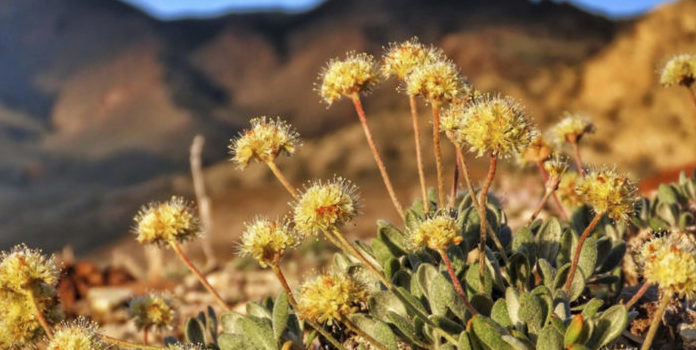(Headline USA) A Nevada wildflower was declared endangered at the only place it’s known to exist—on a high-desert ridge where a lithium mine is planned to help meet growing demand for electric car batteries, U.S. wildlife officials announced Wednesday.
The territorial dispute is now pitting two factions in the Left’s otherwise monolithic green movement against one another as radical conservationists find themselves at odds with those who seek to turn the one-time cottage industry of climate-change activism into big business.
The Fish and Wildlife Service’s formal listing of Tiehm’s buckwheat and its accompanying designation of 910 acres of critical habitat for the 6-inch-tall flower with yellow blooms raises another potential hurdle for President Joe Biden’s “green energy” agenda, although it may indirectly benefit the president’s own financial interests.
Despite the more than trillion-dollar investment in green-energy infrastructure, many of the materials needed to make it viable must come by way of China, where Hunter Biden and other members of the Biden family have a vested stake in energy-production related fields. The president’s son also recently invested in cobalt mines in Africa as part of a partnership with Chinese investors.
Meanwhile, environmental activists and government bureaucrats are using the same tactics they weaponized to delay sections of the U.S.–Mexico border wall as a means to derail one of the few business ventures seeking to mine for rare-earth metals domestically.
With an estimated remaining population of only about 16,000 plants, the Fish and Wildlife Service recently concluded that Tiehm’s buckwheat is on the brink of extinction rather than simply threatened.
“We find that a threatened species status is not appropriate because the threats are severe and imminent, and Tiehm’s buckwheat is in danger of extinction now, as opposed to likely to become endangered in the future,” the agency said.
The proposed mining and mineral exploration poses the biggest threat to the flower. It’s also threatened by road-building, livestock grazing, rodents that eat it, invasive plants and climate change, the service said.
It said an apparent, unprecedented rodent attack wiped out about 60% of its estimated population in 2020.
Ioneer, the Australian mining company that’s been planning for years to dig for lithium where the flower grows on federal land halfway between Reno and Las Vegas, says it has developed a protection plan that would allow the plant and the project to coexist.
But the listing under the Endangered Species Act subjects the mine to its most stringent regulatory requirement to date.
“Lithium is an important part of our renewable energy transition, but it can’t come at the cost of extinction,” said Patrick Donnelly, Great Basin director for the Center for Biological Diversity, which petitioned for the listing in 2019 and sued last year to expedite the plant’s protection.
The mining company said the decision “provides further clarity for the path forward” and is “fully in line with Ioneer’s expectations” for development of the mine site at Rhyolite Ridge in the Silver Peak Range west of Tonopah, near the California border.
“We are committed to the protection and conservation of the species and have incorporated numerous measures into our current and future plans to ensure this occurs,” Ioneer managing director Bernard Rowe said in a statement.
“Our operations have and will continue to avoid all Tiehm’s buckwheat populations,” he said.
The service’s final listing rule will be published Thursday in the Federal Register.
The conservationists who sued to protect the plant insist that Ioneer’s mitigation plan won’t pass legal muster. They pledge to resume their court battle if necessary to protect the buckwheat’s habitat from the rush to develop new lithium deposits.
The flowers are found on a total of just 10 acres spread across about 3 square miles. Federal agencies are prohibited from approving any activity on federal lands that could destroy, modify or adversely affect any listed species’ critical habitat.
Donnelly said the company’s latest operations plan for the first phase of the mine proposes avoiding a “tiny island of land” containing 75% of its population—surrounded by an open pit mine and tailings dumps within 12 feet of the flowers.
The Bureau of Land Management is reviewing the environmental impacts of Ioneer’s latest operations and protection plans.
But Donnelley noted that USFWS estimated in Wednesday’s final listing rule that the proposed scenario would “disturb and remove up to 38% of the critical habitat for this species, impacting pollinator populations, altering hydrology, removing soil and risking subsidence.”
“Ioneer’s ‘Buckwheat Island’ scenario would spell doom for this sensitive little flower,” Donnelly said.
The mine is among several renewable energy-related projects facing legal or regulatory challenges in Nevada.
They include another lithium mine proposed near the Oregon border and a geothermal power plant where the Dixie Valley toad has been declared endangered in wetlands about 100 miles east of Reno.
“Now that the buckwheat is protected, we’ll use the full power of the Endangered Species Act to ensure Ioneer doesn’t harm one hair on a buckwheat’s head,” Donnelly said.
Adapted from reporting by the Associated Press

